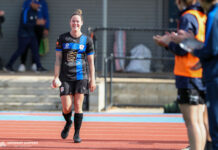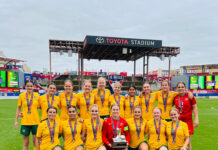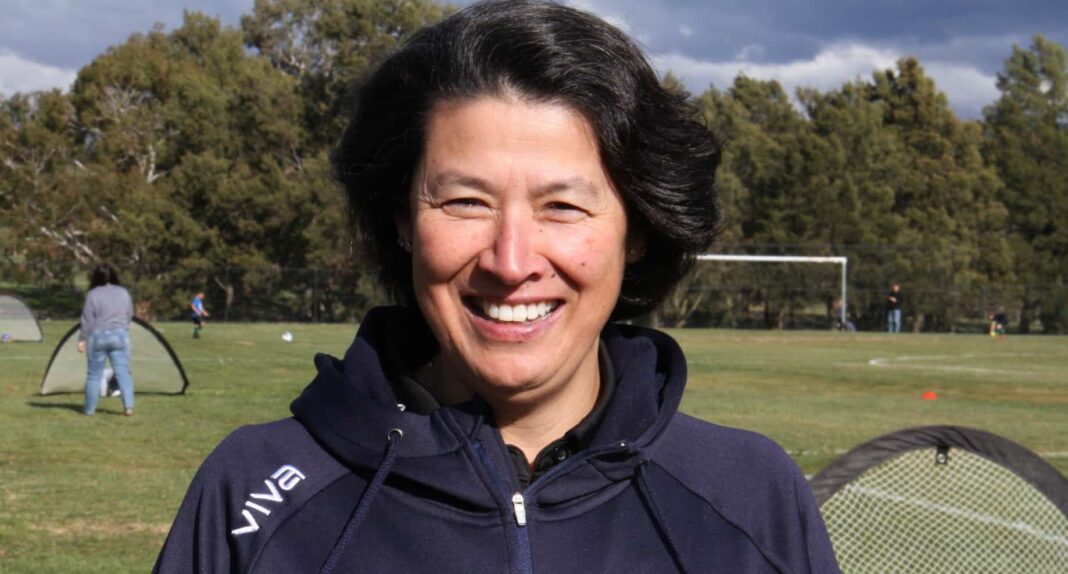
One of Beyond 90’s first-ever feature articles was back in 2019, with then-newly anointed Capital Football chair Fran Sankey. With Sankey’s time at Capital Football now drawing to a close, it’s timely to reflect on her twenty years of work in football governance – and to learn that she’s not done yet!
From being a Tuggeranong United club delegate in 1992 to her time on the Capital Football board, and on to being part of Football Australia’s women’s standing committee, Sankey’s journey illustrates how a life of football passion can be fulfilling for women who are thinking of turning their skills to football governance.
“I moved to the ACT in 1991, then in 1992 I joined the Tuggeranong United women’s soccer team and that’s where it all began. That was in the Women’s Soccer Canberra days and they used to have regular meetings with clubs through what they refer to as a club delegate, so it wasn’t necessarily the President or the Secretary of the club.
“They’d find out the information that Women’s Soccer Canberra had to share and then pass it back to the club; that’s how I first got involved in volunteering in the ACT. A few years later, when I was 30 is when I got involved with competing in my first Masters Games, in 1997 in Canberra.
“We had such a good time. We thought we’d all [stay] together, and then we’ll be better at the next Masters [Games]. So I ended up at Weston Creek [now Weston Molonglo] Football Club and started volunteering there again. I got on the committee but also took on the role of women’s chair for a number of years, [getting involved] with Women’s Soccer Canberra.
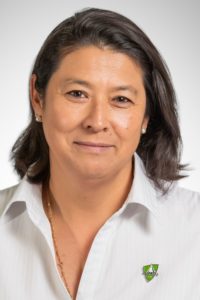
“It must have been around 2003 when there was a major review – the David Crawford review – into football in Australia. Out of that review, the new Football Australia would only recognise one body per jurisdiction. In the ACT at that time, we had Women’s Soccer Canberra, Soccer Canberra and Referees Canberra. They all [then] came under the one umbrella [as Capital Football]. I then chaired the first Women’s Standing Advisory Committee and became a member of Capital Football.
“[I volunteered with Capital Football] for a number of years on the Women’s Standing Advisory Committee until I was elected to the board, I think in 2013. I served on the board for 11 years. There was a little anomaly in the constitution, which says you should do a maximum of three terms of three years as an elected director. But when I was elected the organisation introduced a rotation. Previously, all six elected directors would retire at the same time, which wasn’t good for continuity.
“To introduce this rotation, two directors would retire each year for a three-year period. So I originally was elected for one year; the first person got three years, the next, two, and I got one year. Then I was successfully elected for a three-year term. [At one point] when there were no women on the board, I was appointed for a year, which started my clock again. So I served another year and then was elected again for two successive terms.
Under the current constitution, I could have done another three terms but it’s time for change. That’s why there are limits in the constitution; organisations need change.
“For me, I’ve sat eleven years straight on the board [and] over 20 years straight just in governance directly with Capital Football. If you include the governance role with clubs it’s over 30 years. I need to do things for myself and look at other opportunities.
So now I’m very fortunate to be on the Football Australia women’s football council. I’m not disappearing from football, It’s part of who I am. It would leave a big gap in my life if I wasn’t involved.
Sankey gets a little emotional thinking back to the challenges of not only her early days in football governance as a rare female voice in the room, but also the privilege afforded to her in that space.
“When I first joined the [Capital Football] board, it was a bit daunting. I’d had a long public service career coming into that governance role at the board. Even having been on committees and the chair of Weston Creek women, for me, it was like, oh no, this is the board and it’s more important, I’m going to have to get it right.
“If you look in the ACT there’s a number of female [club] presidents; a couple of years ago, we didn’t have that at all.
I’m just Fran, I love football, but I’d have to be the longest-serving female director in Capital Football, if not in Australian football. Eleven years straight. So I think that’s an amazing achievement and hopefully other women can see that it is doable. It’s that saying, you can’t be what you can’t see. So I think I was very privileged … it actually makes me cry.
I’ve done my best. I gave my heart and soul.
There have been other achievements along the way, and while not every decision was popular, in common they’ve all been for the greater good of football. For example, Sankey is proud of having put together a three-year strategic plan for Capital Football. The plan contains five pillars of focus (‘Govern and guide’, ‘Connect and engage’, ‘Play and perform’, ‘Educate and enhance’, ‘Thrive and prosper’) which can be seen in this October 2021 board meeting summary. Each pillar aims to play a role in bettering the football experience of anyone involved with the game, a theme that Sankey was big on in our 2019 article with her.
“The strategic plan ran for three years, I think it expired last year, but I think they’re still using it, it’s still relevant as it needed to be something that resonated with everybody across the game, that was inclusive of everybody.
That inclusivity part was really important. that’s why football’s so great, it’s a cradle-to-the-grave game.
“We’ve made some tough decisions with Capital Football but for me, I’ve always acted in what’s in the best interest of football in the ACT. Not for a particular club nor for a particular individual, but what’s good for the ACT. So it’s having that more strategic overview where not everybody necessarily understands what’s happening beneath the surface, and long-term impacts.
That’s something I can put my hand on heart and say you know, I did the best job I could do, and I have no regrets with the decisions and how we’ve done them, because it was always in the best interests of football.
One unpopular decision in some quarters – which led to then-CEO Ivan Slavich stepping down in 2023 – was the disbanding of the Canberra United Academy program in favour of a Talented Support Program (TSP). Sankey’s view of the decision is enlightening, and perhaps one that wasn’t widely communicated.
“I remember when we used to have Canberra United boys as well as Canberra United girls. The Premier League men’s clubs said ‘You’ve taken all our boys, you know we shouldn’t have an academy’. Now, if we had an A-League team I’m sure they wouldn’t care at all if we had an academy. We [Capital Football] agreed, but we were absolutely firm that we would have Canberra United girls, and it wasn’t popular [with the clubs] but we had a clear pathway through to an A-League team.
“At the time, the academy was the standard. You had Belconnen United under Ant [Antoni Jagarinec], who set the bar in the competition. The academy had great coaches and the girls played up two years. So if you were in the under 15s you’re a 13-year-old playing in the 15s. And they were still competitive, but they [also played to a guideline whereby] the academy teams couldn’t win the finals. The academy teams were development squads, that’s what their purpose was.
But over time, that changed and the way it ran was changed. The Academy [turned into] a club that was subsidised by every other club, So we’re the administrator as well as a club owner in the competition.
“In the last couple of years, the girls weren’t even playing that upper age group. So if you’re 15 you played in the 15s. It [became] hard to fill a squad – players didn’t necessarily want to come to Canberra United Academy anymore, and that was because, to the credit of the Premier League clubs, they’d lifted their game. I mean you look at Maddy Whittall, she hasn’t come through the academy system, she’s been developed through club land.
“The Academy had served its purpose. So for us, continuing with the academy wasn’t necessarily the best way to go.
You have to acknowledge and understand the past sometimes to be able to go forward.
“The change also aligned with Football Australia’s national directions on forming TSPs [Talented Support Programs].”
Beyond 90 notes that the language around TSPs and Academies isn’t consistent across the various levels of Australian football administration, which doesn’t aid in clarity. For example, the Football Australia guideline from February 2024 refers to the NDS (National Development Scheme), and if you follow that link you will see mention of Academies, Talent ID events, and Talent Development Matches (TDMs), but no mention of TSPs.
Football NSW (here) and Football Northern NSW (here) still talk about TSPs, while Capital Football has both bases covered: here and here. All appear to be dated around the same time as the Football Australia guideline in early 2024.
Sankey’s time as Chair of Capital Football automatically made her a member of Football Australia during her tenure, but it was earlier when she was Deputy Chair circa 2018 that she was elected to the inaugural Football Australia Women’s Council. The council’s brief is to monitor, research, and report on support for women and girls in football.
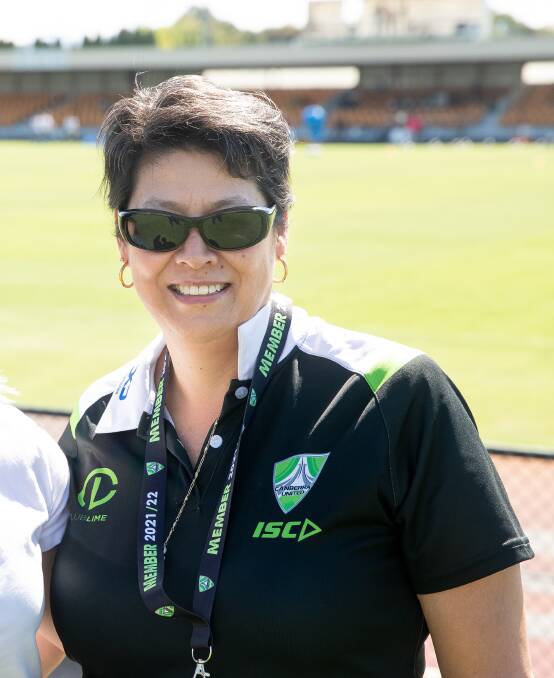
“I think they had a bit of a slow start because it was an inaugural council, so they had to set its tone and what its role would be. COVID stifled progress, [but] now out of the summit we’ve got some very clear direction. The summit had some amazing speakers that I wasn’t familiar with, but I’ll certainly be keeping an eye on them. One of the things I was absolutely delighted with was the level of engagement of everybody in the room. There weren’t just women but there was representation across the whole football ecosystem: from federations, to CEOs, to people from women’s development teams. People from APL clubs, the actual APL, PFA Representatives, the Matildas alumni cohort, and some amazing players I can name-drop like Grace Maher and Emma Ilijoski, who are just amazing young women – they have very bright futures in football and whatever they want to do.
“Out of that, there were a number of priority areas. There are so many things you could focus on but you have to concentrate efforts on something that’s relevant to everybody and what’s doable. There was a focus on that in the workshopping, and from that Football Australia will synthesise all the information that was gathered so we have a road map that all the stakeholders are on board with, which the women’s football council as an advisory committee can keep monitoring. As an advisory group, we’re not there to replace operational staff, nor are we able to [enforce recommendations], to be clear.”
Sankey goes on to explain the council membership and criteria as laid out in the constitution.
“[Membership] criteria revolves around experience and knowledge in relation to grassroots and/or professional football, refereeing, coaching, governance, or football administration. Currently, there are ten members, and three are nominated by (but not representatives of, to be clear) member federations; three by the professional league clubs; and three by the PFA. The chair is elected independently of those cohorts – by the nominations committee, which is the standing advisory committee – and then ratified by the members.
“The 40/40/20 principle applies [to the standing advisory committee]. Some people don’t find that comfortable, thinking it’s a women’s council, it should be only women, but the 40/40/20 principle is about making sure that there’s a different gender balance; there are some very good men involved in women’s sport. And sometimes that can be more powerful if men are championing things; other men think ‘I can too’.
“The women’s council currently consists of nine women and one man, a man with humanitarian/refugee expertise. It can [also] co-opt members for a specified term for a specified purpose/expertise.”
The discussion finishes with some thoughts on the challenges ahead for the Capital Football board under CEO Samantha Farrow.
“For me, the board is there to provide that strategic direction and oversight and I think the board got too involved in operational matters the last few years. It’s been hard in the last couple of years, we’ve had periods where the CEO wasn’t filled.
So certainly it’s making sure that the board performs the role of the board and leaves the CEO to manage the operational side of things.
“So, I think that’s probably a key thing for any board to have that clear separation. Samantha Farrow has come into what I consider to be a very tough job and she’s off to a really good start. I wish her well, and she needs the support of the board to continue to do things.
“There isn’t a [updated] strategic plan at the moment. Football Australia has a strategic plan now too and it needs to cascade down from that. And also for the organisation, we need to look at all elements of the game. There’s a lot of focus on the higher level and the elite, but it all starts at the grassroots – we need to continue to make sure we’ve got the right infrastructure and support and not put so much work onto the volunteers. That’s probably more of an operational matter.
“Refereeing is an area where I think all member federations struggle a little bit. How can we work together across all member federations? That was certainly something that came out of the women’s summit, on how can we utilise all the resources that are around, as there is a lot of duplication. We have nine member federations, why do we do everything times nine?
My message for other women is, if you want to get involved, there’s so many opportunities and unless you have a go, you never know.
“Yes it can be a bit daunting but we need people involved in football volunteering at club level in governance. I’m hoping that people see that it is possible to get involved.
“Regarding Canberra United, [preparations for season 17 are advanced and] just let’s all get behind the team. Come to the games, make a difference, tell a prospective buyer there’s something to get behind.
“Sometime in the future, I might get more significantly involved back in football. But I think for now it’s probably good for everybody for me to step back – women’s council aside – and enjoy playing and watching football. I love going and watching the little MiniRoos and the talent of some of these kids, they’re starting so young. Nowadays you start at the age of six and by the time you’re 14, you’re Grace Maher, you’re Emma Iiljoski. The other day there were all these little Belconnen United girls lining up for these older [local] girls at the NPLW game and I’m thinking it’s just like Matildas, it’s great.”





